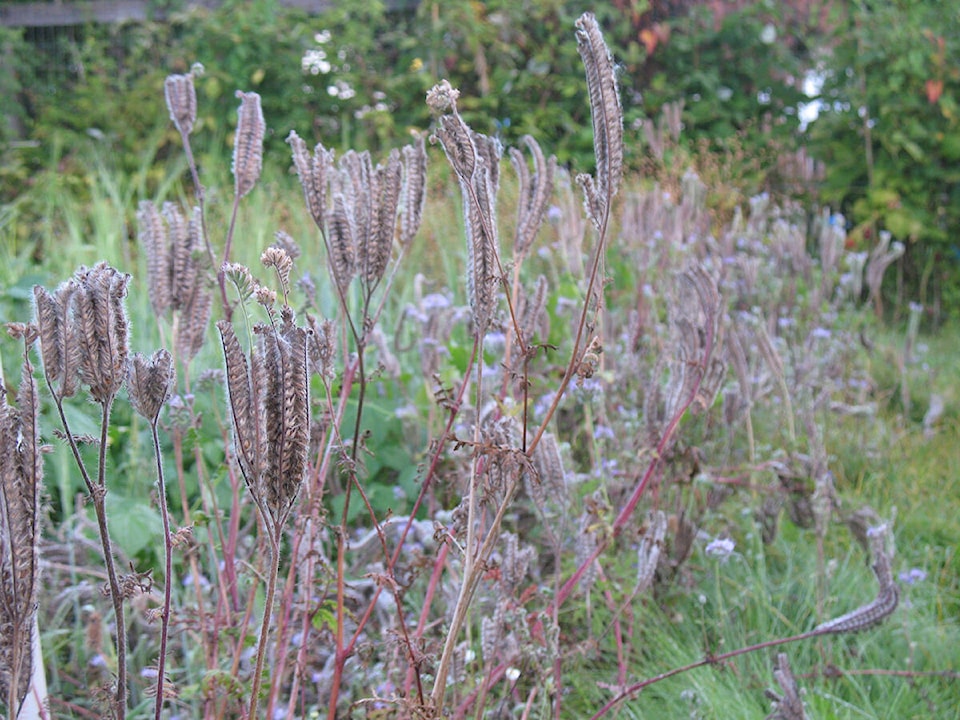By Mary Lowther
When a long term relationship breaks up, the custody arrangements can be difficult. Never mind the kids and pets; who gets to keep the rest of the extended clan? After 20 years there are the aunts, uncles and cousins to consider, and sometimes those bonds are too strong to be broken. This serves to explain my “cousin,” a member of the Tsimsian nation, who has shared my sense of humour and world outlook for more than a quarter century since we were technically unfamilied.
I recently asked him when we were going to get our “second summer” this year and he said we’ve already had it. I protested that two days of sunshine between monsoons hardly counted and he just shrugged and suggested I use what time I had left. It’s hard to argue with a man when he’s right; it’s even harder to admit it.
Fortunately our nights have been warm this past week, so I’m pushing the gardening envelope to sow cover crop on areas I hadn’t gotten to yet. Cover crops are plants grown for several reasons, none of which include being eaten. They can retain nutrients and microscopic life forms, prevent erosion and the growth of weeds, soften the soil by adding their nutritious mass to it and create passageways for earthworms and other beneficial organisms as their roots rot, but perhaps the greatest contribution cover crops make is helping to create a sponge-like soil that holds water in place during summer drought, keeping it available for food crops. This might make a difference between having a harvest and going hungry.
Cover cropping has been used in China for more than 3,000 years and in the Mediterranean for 2,000, but was not employed in northern Europe until the 17th century. This may be because of the low literacy levels among the peasantry, assuming that any of the literati wrote about it in the first place. One suspects that the nobility and clergy assumed that fruit and vegetables grew themselves.
The earliest indication otherwise was when Henry VII, missing the peas and carrots he had enjoyed while growing up in Gascony, ordered their import and cultivation in England circa 1490. Until then Britons had evidently survived on kale and turnips. The concept of cover crops appears to have arrived about the same time, presumably carried by Muslim traders along with the “Arabic” numerals they learned from the genuine Indians who invented them.
As with vegetables, cover crops come in various shapes and sizes because each has been developed for different seasons and reasons: thus spring, summer and winter crops often aren’t interchangeable. Now I will sow those suited for fall and winter use; legumes like fava beans and grasses like winter rye and wheat.
Although winter rye germinates well in low temperatures and has massive roots, it grows quickly when the soil warms up, so when we have a wet spring and can’t get into the garden it can become difficult to cut down and dig under. I think I’ll sow some anyway and plan on getting out there rain or shine early next year to dig it under because winter rye adds the most root biomass of all the cover crops and therefore retains more nutrients in the soil. Legumes like fava beans add nitrogen to the soil and, since they have grown well for me previously, I’ll sow them again.
Winter crops like leeks and kale and overwintering crops like garlic, onions, turnips and purple sprouting broccoli also help retain nutrients in the soil, and when they come out I’ll sow their beds with spring and summer cover crops. Any bed left vacant for three or more weeks can be sown to good effect.
Mulches like leaves might work to prevent erosion among winter and overwintering crops as long as the garden isn’t riddled with slugs or other varmints that might find the mulch canopy a nice, cozy spot to overwinter. I piled leaves over my freshly-sown garlic cloves last year and they came through winter very well.
A flower called “phaecelia” is an excellent cover crop that improves soil structure and attracts bees all summer as it blooms, but the seed doesn’t come cheap. I sowed a small packet last year intending to harvest the seed to use as a cover crop and this year I used the resulting seed to grow more. I’m doing the same with a long row of fava beans too. Once I let plants go to seed and remove them, however, I have also removed many nutrients from the plants and cannot consider what I’ve done as cover cropping. If I want to grow a food crop there, I have to add extra nutrients to the soil.
Please contact mary_lowther@yahoo.ca with questions and suggestions since I need all the help I can get.
